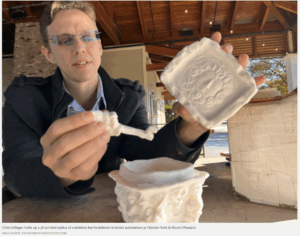Cooking show star Paula Deen lost her lucrative gig on the Food Network more than a year ago in an ugly scandal arising out of racist language Deen admitted to having used when she was deposed in a lawsuit filed by a female manager against Uncle Bubba’s Seafood and Oyster House, which Deen owns with her brother in Savannah. Lisa Jackson, the manager, was white, but she charged that the environment of sexual harassment extended to racial discrimination.
But the author’s decision not to pile on the criticism reflects a serious, not to say high-minded, approach to her topic that serves Ferris well.Taking a hard but nuanced look at the evolution of farming, cooking, eating, and restaurants in a region with an unresolved struggle of identity, Ferris delivers a textured, illuminating, and often powerful narrative about how image trumped reality in the popularization of Southern food.Ferris treats celebrity machinery as a means of whitewashing the past. In 1893, for example, an ex-slave named Nancy Green who had become a domestic worker in Chicago landed a job at the World’s Columbian Exposition, promoting Aunt Jemima Pancake Flour.
In this fabrication, Aunt Jemima’s “superior culinary skills saved both starving Confederate soldiers andcontemporary housewives struggling to please their busy husbands at breakfast time,” notes the author.The diseases are different today—diabetes and obesity instead of pellagra and typhoid—but the causes behind these conditions remain the same.Meanwhile real Southern mammies subsisted on tenant farms and in sharecropper communities where they were forced “to buy the cheapest and most filling food they could find for their families at the plantation commissary or a store in town, a monotonous diet dependent on cornmeal, salt pork, field peas or beans, and molasses,” writes Ferris.
“The diseases are different today—diabetes and obesity instead of the New South’s pellagra and typhoid—but the causes behind these conditions remain the same: poverty and racial disenfranchisement of generations of working-class Southerners.”The Edible South focuses on the little-known stories of educators at black colleges who did field research with the poorest Southerners and taught young women from a threadbare middle class about wiser diet and food choices. Michelle Obama’s campaign against obesity is a new chapter in that long history.
The book drags occasionally as Ferris casts a wide net on the researchers, sociologists, folklorists, and activists who provided major documentation for the narrative. But the emphasis has its logic when she provides a backstory to the James Agee-Walker Evans 1941 classic, Let Us Now Praise Famous Men,identifying the Depression-era sharecroppers they stayed with, the food the people ate, their daily struggles, and how Fortune magazine, which sent the writer and photographer on the assignment, killed the story when it was done.
Ferris portrays Edna Lewis, a black chef whose long career began in ’50s New York and lasted into the ’90s in North Carolina and Atlanta. One of the first American cooks to extol the use of local ingredients in her cookbooks and her kitchens, Lewis was known for her “quiet but demanding quest for pure ingredients and authentic flavors [that] caught the attention of the ‘new regionalists,’ including Alice Waters… [Lewis] worried about the destructive impact of commercial food production and chemical fertilizers upon flavor, recalling an era in the rural South when composted manure, wood ash, and lime ‘sweetened’ the soul.”
Ferris shows long reach in this book, as in her section on Lena Richard and Mary Land, who both played major roles in popularizing Louisiana Creole cuisine. Land, born into a privileged north Louisiana family, studied journalism at University of Chicago and became a writer on sports fishing and a syndicated columnist before her interest turned to cooking. Ferris credits her booksLouisiana Cookery (1954) and New Orleans Cuisine (1969) as exemplars of diligent reporting and research.
Lena Richard was a black caterer and owner of the Gumbo House who publishedNew Orleans Cookbook in 1940. She had a twice-weekly cooking show on the NCB affiliate, WDSU TV in 1949-50.
Ferris has a sharp eye for the odd-angle anecdote, as in her section on the role food played in nurturing the civil-rights struggle. At one end, battle-weary activists who made it to New Orleans found welcoming meals at Dooky Chase’s Restaurant, an iconic institution then and more so today.
Activist Bernard Lafayette, who was convicted on trumped-up charges and sent to Mississippi’s notorious Parchman Penitentiary, made a point of praising the people who prepared the meals. As in most prisons, the “trusty” was a convict the warden trusted and thus had special privileges. “The jailer had a high-school-age daughter and was uncertain how to help her get in college,” writes Ferris. “Lafayette and other imprisoned college students shared helpful advice with him. The trusty hid the pints of ice cream for the students in his mop bucket.” When they were finally released, Lafayette explained, “I remember the very words [the jailer] said: Y’all come back to see me, hear?’
“The Edible South concludes with a dose of bittersweet realism. Ferris writes of “two poles in the region today—one of distinctive, innovative foods grounded in tradition, and the other, an inheritance of racial and class trauma, expressed in land loss, poverty, and disease.”

Much of the dichotomy that Ferris pinpoints is the product of an ever-commercialized “sweet South” where bad times now are pointedly ignored so that cultural economies may sing. How to rebuild from that “inheritance of trauma?” Ferris is a member of Southern Foodways Alliance, a group of scholars, writers, chefs, restaurateurs, documentarians, and enthusiasts who explore the culinary culture with hope for regional redemption. They may be onto something. Expanding economies are like red wine for the human heart.
–Jason Berry, The Daily Beast


